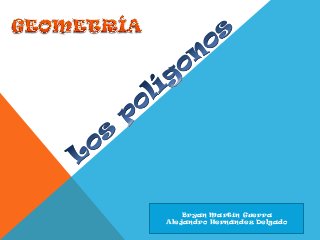
Geometría. los polígonos
- 1. Bryan Martín Guerra Alejandro Hernández Delgado
- 3. Estudiantes, este WebQuest fue hecho pensando en ustedes!! Les ayudará de manera divertida a clasificar los polígonos, hallar sus perímetros y sus áreas. Ahora bien, un conocimiento geométrico básico es indispensable para desenvolverse en la vida cotidiana: para orientarse reflexivamente en el espacio; para hacer estimaciones sobre formas y distancias; para hacer apreciaciones y cálculos relativos a la distribución de los objetos en el espacio…etc.
- 4. El propósito de este WebQuest es que ustedes logren comprender qué es un polígono, cómo clasificarlos, cómo calcular su perímetro y cómo hallar su área. Para lograr esto, realizarán las siguientes tareas: Tarea 1. Clasificación de los polígonos. (Selección múltiple). Dependiendo de la figura que aparezca, clasificarás la figura con su nombre correcto. En la sección de proceso se explica en detalle está tarea y allí encontraras todo lo necesario para poderla realizar. Tarea 2. Hallar el perímetro del polígono. Tienes que observar la figura dada y las medidas que la rodean, luego puedes usar la calculadora para hallar el perímetro. En la sección de proceso se encuentra más en detalles la realización de ESTA TAREA. Tarea 3. Hallar el área del polígono. Tienes que analizar y observar la información dada para poder aplicar las fórmulas necesarias para hallar el área de esos polígonos. Puedes utilizar la calculadora. En la sección de PROCESO se explicará más en detalle cómo realizar estas tareas.
- 5. Para poder hacer las tareas mencionadas en la sección anterior primeramente necesitas saber qué son los POLÍGONOS. Para averiguar esto necesitas entrar a los 2 siguientes “LINKS”: 1)http://images.google.com.pr/imgres?imgurl=http://webdelprofesor.ula.ve/nucleotrujillo/ alperez/teoria/cap_01a-conceptos_geometricos/cap_01a- imagenes/poligonos_regulares.gif&imgrefurl=http://webdelprofesor.ula.ve/nucleotrujillo/al perez/teoria/cap_01a-conceptos_geometricos/04- poligono.htm&usg=__kCmY4ezMcCnVSABtW9- sJSZ2MQA=&h=230&w=634&sz=20&hl=es&start=2&um=1&itbs=1&tbnid=_m- vezQkad8N7M:&tbnh=50&tbnw=137&prev=/images%3Fq%3Dpoligonos%26um%3D1%26 hl%3Des%26sa%3DN%26rlz%3D1T4ADBF_esPR279PR280%26tbs%3Disch:1 2)http://www.geoka.net/geometria/area.html Estos dos “LINKS” te brindan toda la información necesaria para poder realizar las 3 Tareas asignadas.
- 6. Tarea 1. Clasificación de los polígonos 1) Vas a entrar al siguiente “Link” http://www.thatquiz.org/es/mc?HRLE7464 2) Cuando entres al Link vas a seguir las instrucciones que aparecen. Así que, vas a identificar las figuras geométricas que aparecen. Se supone que veas 18 ejercicios. 3) Vas a contestar los 18 ejercicios en tu libreta de la clase. Tarea 2. Hallar el perímetro del polígono 1) Vas a abrir el documento de WORD titulado Tarea#2 que se encuentra en esta misma página más abajo en la parte de RESOURCES. Es el attachment 1. 2) Una vez hallas abierto el documento lo vas a imprimir, luego lo contestas completo y lo llevas para el salón de clases para discutirlo. Tarea 3. Hallar el área del polígono 1) Vas a seguir exactamente los mismos pasos de la tarea#2 pero ahora vas a abrir el documento de WORD titulado Tarea#3: Calcular el área. Es el attachment 2.
- 7. DEFICIENTE REGULAR BUENO EXCELENTE Puntos Tarea 1 0-64% de los ejercicios correctos 65%-77% de los ejercicios correctos 78%-89% de los ejercicios correctos 90%-100% de los ejercicios correctos 30% Tarea 2 obtuvo 2.5/5 ó menos obtuvo 3/5 ó 3.5/5 obtuvo 4/5 ó 4.5/5 obtuvo 5/5 30% Tarea 3 si obtienes 2 puntos o menos si obtienes 2.5 a 3 puntos si obtienes 3.5 a 4 puntos si obtienes 4.5 a 5 puntos 30% Puntualidad No entrego la libreta ni los papeles se tardo dos días o más en entregar los documentos Se tardo 1 día en entregar todo Entregó la libreta y los dos papeles de ejercicios el día estipulado 10% Puntuación total 100%
- 8. Si observas tú alrededor te darás cuenta de que los objetos que nos rodean tienen forma de polígonos. Algunos de los lugares a los cuales asistes a jugar, estudiar o de vacaciones, tienen forma de diferentes polígonos; observa las canchas, la piscina o simplemente los pasillos. Inclusive, nuestra naturaleza comprende formaciones en forma de polígonos. Ahora bien, estas figuras de dos dimensiones llamadas Polígonos, van a servir de base para la formación de otras figuras en tres dimensiones denominadas Cuerpos Geométricos. La geometría está presente en múltiples ámbitos del sistema productivo de nuestras actuales sociedades (producción industrial, diseño, arquitectura, topografía, etc…). La forma geométrica es también un componente esencial del arte y representa un aspecto importante en el estudio de los elementos de la naturaleza. ¡¡Esperamos que hayan disfrutado esta nueva experiencia de aprendizaje y les deseamos ÉXITO en sus estudios!!
